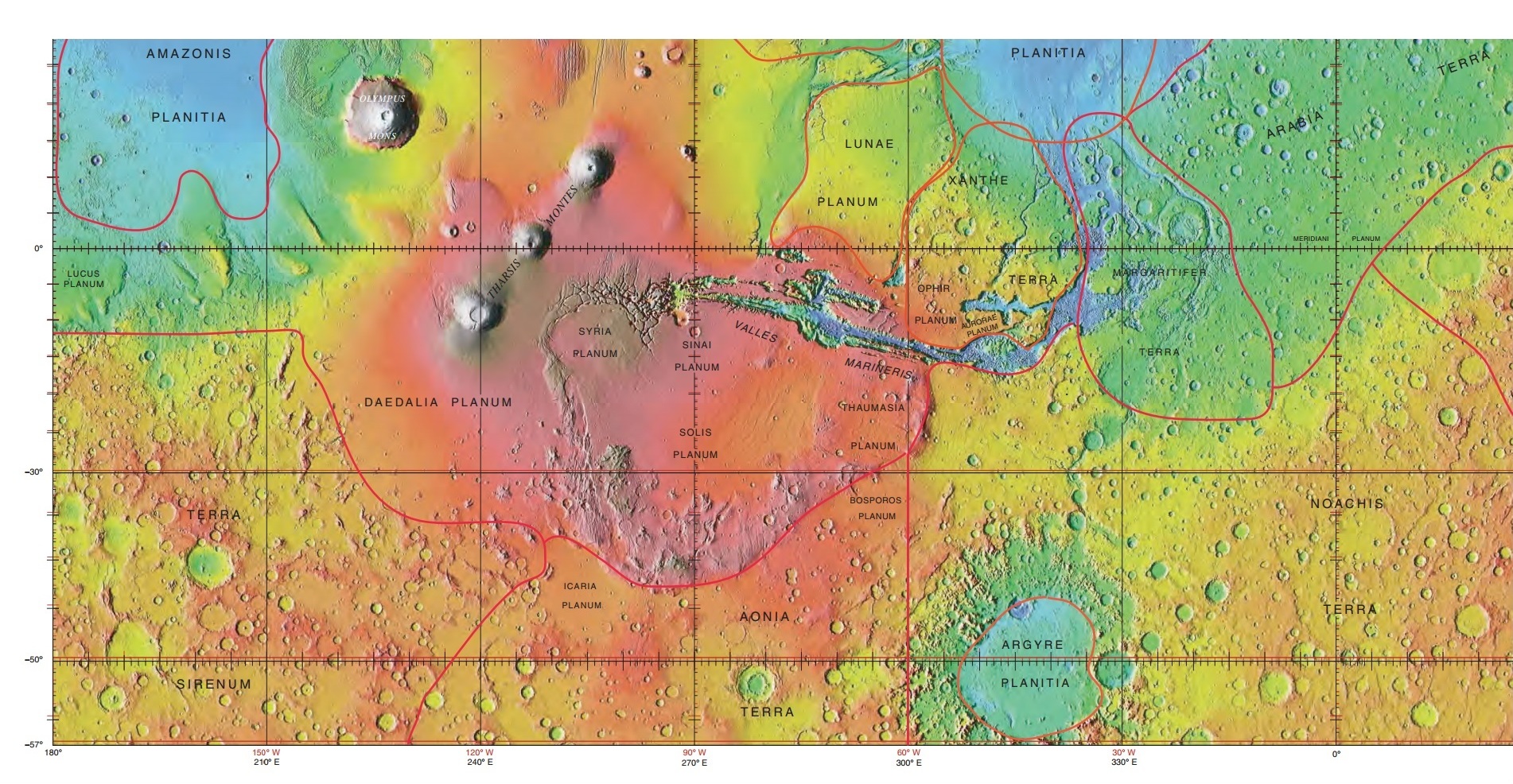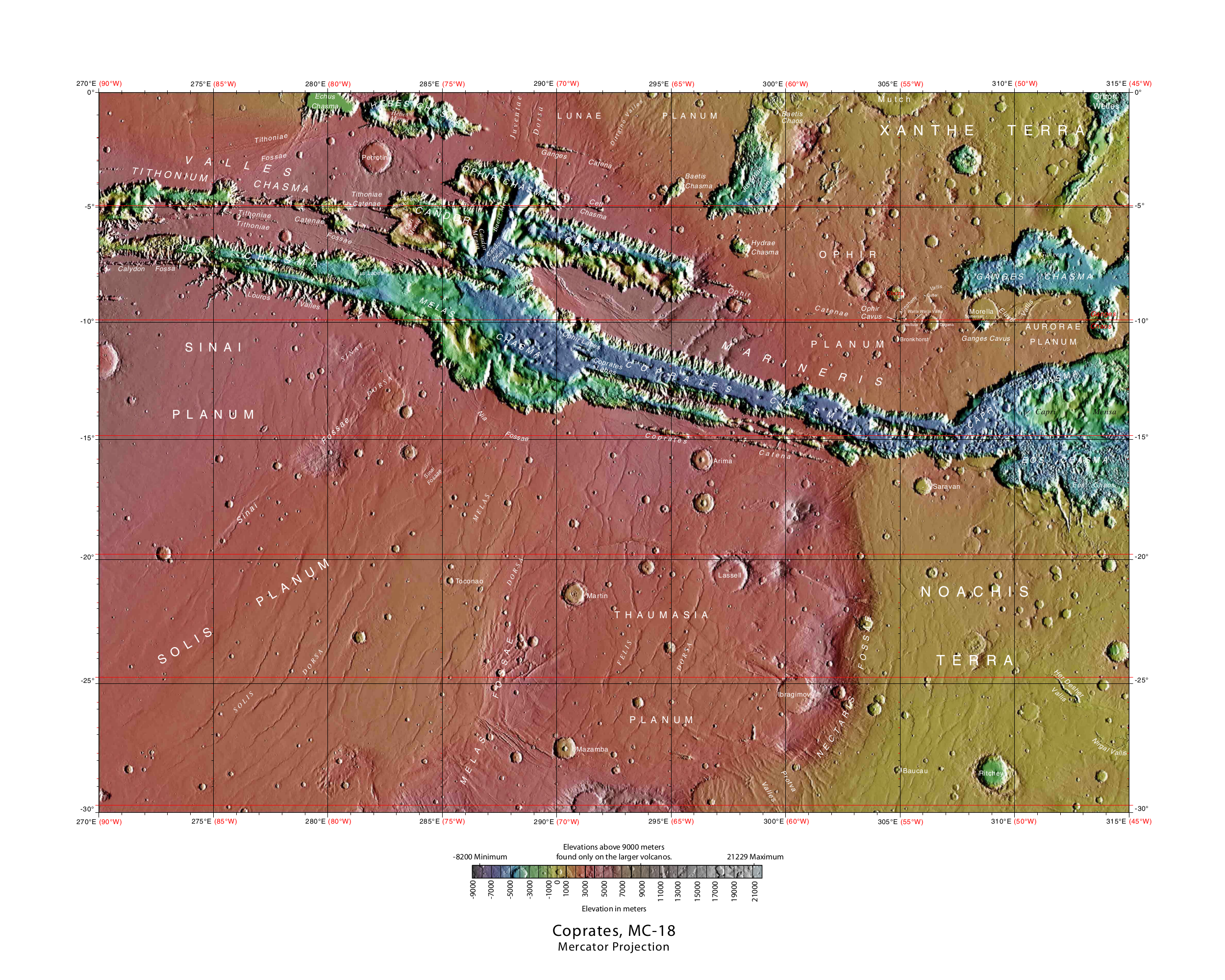|
Solis Planum
Solis Planum is a planum on Mars which has a diameter of 1811.23 km. Its center latitude is 26.4 S and its center longitude is 270.33 E. Solis Planum was named after a classic albedo feature name, and its name was approved in 1973. Gallery ESP 044840 1620lavaflow.jpg, Edge of lava flow, as seen by HiRISE under HiWish program Interactive Mars map References {{Reflist See also * Phoenicis Lacus quadrangle * Volcanism on Mars Volcanic activity, or volcanism, has played a significant role in the geologic evolution of Mars. Scientists have known since the Mariner 9 mission in 1972 that volcanic features cover large portions of the Martian surface. These features in ... 1973 in science Coprates quadrangle Phoenicis Lacus quadrangle Plains on Mars Thaumasia quadrangle ... [...More Info...] [...Related Items...] OR: [Wikipedia] [Google] [Baidu] |
Planum
In geology and physical geography, a plateau (; ; ), also called a high plain or a tableland, is an area of a highland consisting of flat terrain that is raised sharply above the surrounding area on at least one side. Often one or more sides have deep hills or escarpments. Plateaus can be formed by a number of processes, including upwelling of volcanic magma, extrusion of lava, and erosion by water and glaciers. Plateaus are classified according to their surrounding environment as intermontane, piedmont, or continental. A few plateaus may have a small flat top while others have wide ones. Formation Plateaus can be formed by a number of processes, including upwelling of volcanic magma, extrusion of lava, Plate tectonics movements and erosion by water and glaciers. Volcanic Volcanic plateaus are produced by volcanic activity. The Columbia Plateau in the north-western United States is an example. They may be formed by upwelling of volcanic magma or extrusion of lava. The un ... [...More Info...] [...Related Items...] OR: [Wikipedia] [Google] [Baidu] |
Mars
Mars is the fourth planet from the Sun and the second-smallest planet in the Solar System, only being larger than Mercury (planet), Mercury. In the English language, Mars is named for the Mars (mythology), Roman god of war. Mars is a terrestrial planet with a thin atmosphere (less than 1% that of Earth's), and has a crust primarily composed of elements similar to Earth's crust, as well as a core made of iron and nickel. Mars has surface features such as impact craters, valleys, dunes and polar ice caps. It has two small and irregularly shaped moons, Phobos (moon), Phobos and Deimos (moon), Deimos. Some of the most notable surface features on Mars include Olympus Mons, the largest volcano and List of tallest mountains in the Solar System, highest known mountain in the Solar System and Valles Marineris, one of the largest canyons in the Solar System. The North Polar Basin (Mars), Borealis basin in the Northern Hemisphere covers approximately 40% of the planet and may be a la ... [...More Info...] [...Related Items...] OR: [Wikipedia] [Google] [Baidu] |
Phoenicis Lacus Quadrangle
The Phoenicis Lacus quadrangle is one of a series of 30 quadrangle maps of Mars used by the United States Geological Survey (USGS) Astrogeology Research Program. The Phoenicis Lacus quadrangle is also referred to as MC-17 (Mars Chart-17). Parts of Daedalia Planum, Sinai Planum, and Solis Planum are found in this quadrangle. Phoenicis Lacus is named after the phoenix which according to myth burns itself up every 500 years and then is reborn. The Phoenicis Lacus quadrangle covers the area from 90° to 135° west longitude and 0° to 30° south latitude on Mars. The Tharsus rise, which was formed from lava flows, occupies part of area. The volcanoes Pavonis Mons and Arsia Mons are believed to have once had glaciers on them. Glaciers may still exist under a thin layer of rocks. The ice can be a source of water for the possible future colonization of the planet. One of the most prominent features of this quadrangle is a large intersecting set of canyons called Noctis Labyrinthu ... [...More Info...] [...Related Items...] OR: [Wikipedia] [Google] [Baidu] |
Volcanism On Mars
Volcanic activity, or volcanism, has played a significant role in the geologic evolution of Mars. Scientists have known since the Mariner 9 mission in 1972 that volcanic features cover large portions of the Martian surface. These features include extensive lava flows, vast lava plains, and the largest known volcanoes in the Solar System. Martian volcanic features range in age from Noachian (>3.7 billion years) to late Amazonian (< 500 million years), indicating that the planet has been volcanically active throughout its history, and some speculate it probably still is so today. Both and Mars are large, differentiated |
1973 In Science
The year 1973 in science and technology involved some significant events, listed below. Astronomy and space exploration * March 7 – Comet Kohoutek is discovered * April 6 – Launch of Pioneer 11 spacecraft * May 14 – ''Skylab'', the United States' first space station, is launched. * Solar eclipse of June 30, 1973 – Very long total solar eclipse visible in NE South America, the Atlantic, and central Africa. During the entire Second Millennium, only seven total solar eclipses exceed seven minutes of totality; this is the last. Observers aboard a Concorde jet are able to stretch totality to about 74 minutes by flying along the path of the moon's umbra. * July 25 – Soviet Mars 5 space probe launched. * November 3 – Mariner program: NASA launches the Mariner 10 toward Mercury (on March 29, 1974, it becomes the first space probe to reach that planet); it will be the first space flight to use gravity assist. * December 3 – Pioneer program: Pioneer 10 sends back the first cl ... [...More Info...] [...Related Items...] OR: [Wikipedia] [Google] [Baidu] |
Coprates Quadrangle
The Coprates quadrangle is one of a series of 30 quadrangle maps of Mars used by the United States Geological Survey (USGS) Astrogeology Research Program. The Coprates quadrangle is also referred to as MC-18 (Mars Chart-18). The Coprates quadrangle contains parts of many of the old classical regions of Mars: Sinai Planum, Solis Planum, Thaumasia Planum, Lunae Planum, Noachis Terra, and Xanthe Terra. The name Coprates refers to Coprates Chasma, a central trough of the Valles Marineris, named after the Greek name of the Dez River in Persia. The Coprates quadrangle goes from 45° to 90° west longitude and 0° to 30° south latitude on Mars. Coprates quadrangle is famous for depicting the "Grand Canyon of Mars", the Valles Marineris Canyon System. Signs of water exist in this quadrangle, with ancient river valleys and networks of stream channels showing up as inverted terrain and lakes inside of Valles Marineris.Cabrol, N. and E. Grin (eds.). 2010. Lakes on Mars. Elsevier ... [...More Info...] [...Related Items...] OR: [Wikipedia] [Google] [Baidu] |
Plains On Mars
In geography, a plain is a flat expanse of land that generally does not change much in elevation, and is primarily treeless. Plains occur as lowlands along valleys or at the base of mountains, as coastal plains, and as plateaus or uplands. In a valley, a plain is enclosed on two sides, but in other cases a plain may be delineated by a complete or partial ring of hills, by mountains, or by cliffs. Where a geological region contains more than one plain, they may be connected by a pass (sometimes termed a gap). Coastal plains mostly rise from sea level until they run into elevated features such as mountains or plateaus. Plains are one of the major landforms on earth, where they are present on all continents, and cover more than one-third of the world's land area. Plains can be formed from flowing lava; from deposition of sediment by water, ice, or wind; or formed by erosion by the agents from hills and mountains. Biomes on plains include grassland (temperate or subtropical), st ... [...More Info...] [...Related Items...] OR: [Wikipedia] [Google] [Baidu] |





